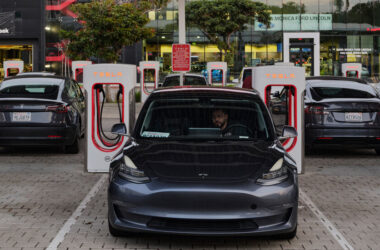Self-driving cars have been crowned the future of the automotive industry, but in their current form, the software powering those vehicles is stuck in the present.
One significant flaw in the self-driving systems has yet to be worked out, according to experts. When there’s potential for an accident, the systems often return control to the human driver without enough time for them to avoid a collision, automotive industry experts told CBS MoneyWatch. In other words, that the software does not know how to react when the unexpected happens, such as animal darting onto the road.
The major flaw came to bear earlier this year when a Ford Mustang Mach-E SUV crashed into a 56-year-old Texas man who was driving a Honda CR-V. The Mach-E had its partially self-driving feature — which Ford calls BlueCruise — activated during the crash, in which the CR-V driver was killed. On Monday, the National Highway Traffic Safety Administration (NHTSA) said it’s looking into what role BlueCruise played in causing the Texas accident.
But Monday isn’t the first time NHTSA has launched an investigation into self-driving vehicles. The BlueCruise probe follows a 2022 NHTSA investigation into what caused robotaxis run by General Motors’ autonomous software, Cruise, to stop short or quit moving altogether. NHTSA has also launched several investigations into crashes involving Tesla’s autopilot feature dating back to 2021.
The NHTSA investigations are proof that even though autonomous driving is considered the next competitive frontier for automakers, the technology still hasn’t matured enough for widespread usage, Robert Sumwalt, CBS News’ transportation safety analyst told CBS MoneyWatch.
“It’s not a perfect science yet,” said Sumwalt, a former chairman of the National Transportation Safety Board. “Right now it’s like trying to send a rocket to the moon in 1910 when the Wright Brothers were still working on their planes.”
The makings of vehicle autonomy
The self-driving mode most automakers have today is known in the industry as Level 2. There are six increasing levels of autonomy in total.
Essentially, Level 2 is a vehicle with an on-board computer equipped with a map in its database. The vehicle is also outfitted with camera sensors, radars, lidar (light and range detection) and ultrasonic systems, all of which work together to detect what’s going on around the vehicle in real time.
“The maps they have on them can drive perfectly, if there’s nothing on the road,” Sean Tucker, senior editor at Kelley Blue Book and Autotrader told CBS MoneyWatch. “It’s a problem if someone stops in the middle of a highway or if a deer runs out in the middle of the road. That’s the hard part for the computer.”
Ford’s BlueCruise is a Level 2 system that allows drivers to take their hands off the steering wheel while the vehicle handles steering, braking and acceleration on highways. A Ford spokesperson told CBS MoneyWatch that the company aspires to upgrade BlueCruise to Level 3 autonomy, which among other things would enable a vehicle to perform more advanced tasks like accelerate past a slow driver or inch ahead during a traffic jam.
“By enabling hands-free, eyes-off driving in certain conditions like long stretches of highway or stop-and-go traffic, this technology has the potential to offer drivers the freedom to use their time behind the wheel in more productive and enjoyable ways during parts of their journey,” the Ford spokesperson told CBS MoneyWatch in an email.
Like many other major automakers, Ford is betting big on self-driving vehicles. The company last year created its own in-house division for automated driving systems called Latitude AI, devoted to improving BlueCruise.
During a 2023 company event, Ford’s electric vehicle chief Doug Field outlined how aggressively the automaker wants to move toward self-driving.
“We want L3 to work everywhere BlueCruise works,” he said. “The key use cases that we see are stop-and-go traffic — which is really tedious and actually a cause of a lot of accidents because people take their mind off of what’s going on — and then steady-state cruise long trips, in which, the same thing, you can tend to get bored or sleepy.”
Race for the Holy Grail
Self-driving cars are much more advanced now compared to when they were first developed, said K. Venkatesh Prasad, senior vice president of research at the Center for Automotive Research. Still, they have to be able to navigate, not only humans driving cars and trucks, but people making unpredictable moves on scooters, skateboards and bicycles, Prasad told CBS MoneyWatch.
Automakers are testing their self-driving cars on closed tracks as much as they can, but they can advance the technology faster by putting the vehicles on an actual road, Sumwalt said. But real-world testing, he said, comes at a high price — crashes, fatalities and federal investigations.
Indeed, Ford, GM, Mercedes-Benz, Nissan, Subaru and Tesla all have a variation of Level 2 autonomous driving. They’re all in a technology arms race to perfect self-driving and claim all the benefits that come with it, experts said.
“If you can be first to this Holy Grail of autonomy, you get a lot of attention,” said Jonathan Elfalan, director of vehicle testing at Edmunds. “And you are probably going to make profit off the end of it.”








